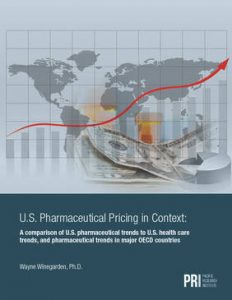A more realistic evaluation of U.S. prescription drug prices shows that high drug prices are not actually driving up health care costs overall, and reflect the higher U.S. health care costs compared to the rest of the world, according to a new report released today by the Pacific Research Institute.

“It’s a common misperception that expensive prescription drug costs are driving up America’s health care costs overall,” said Dr. Wayne Winegarden, PRI Senior Fellow in Business and Economics, and the study’s author. “Our new study finds that drug price growth is actually not driving the growth in health care costs at all. Reforms to reduce complexity and increase transparency in drug pricing could go a long way to help consumers make informed choices and reduce prescription drug costs.”
Click here to download a copy of U.S. Pharmaceutical Pricing in Context.
Winegarden notes in the study that it is commonly assumed that drug prices are the primary cause of America’s health care affordability problem. This is due to the current overly-complex pricing system. Most evaluations, he argues, focus incorrectly on the list prices of the drugs. However, this is a distorted view as these vary significantly from the net prices, or the prices consumers pay following all discounts and negotiated payments.
Among the other key points in U.S. Pharmaceutical Pricing in Context:
- Since 1969, health care inflation has outpaced drug price inflation. More recently, drug price inflation has increased, likely driven by hospital drug prices, and the increase in new, novel medications. Typically, drug prices rise at a faster rate when there are more innovations.
- Total expenditures on pharmaceuticals relative to overall health care expenditures have risen and fallen in an unrelated matter. This shows that increases in drug prices are not driving increases in health care costs.
- An apples-to-apples comparison of U.S. drug prices with those in other countries, adjusted for higher overall medical price inflation, show that higher U.S. drug prices simply reflect higher overall domestic medical prices.
- The current drug pricing process – which involve intermediaries like Pharmacy Benefit Managers (PBMs) – includes perverse incentives that drive up costs. Reforms to simplify this process would enable list prices to reflect transaction costs more accurately.
- Additionally, hospitals are reimbursed for the price paid for drugs under Medicare Part B. Reforms to provide reimbursement based on the value of the drug, not the cost, would help drive down costs and increase information available for doctors, pharmacists, and patients.
Dr. Wayne Winegarden is a Senior Fellow in Business and Economics at Pacific Research Institute. He is also the Principal of Capitol Economic Advisors and a Managing Editor for EconoSTATS.
